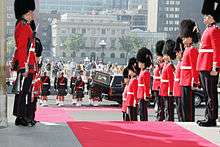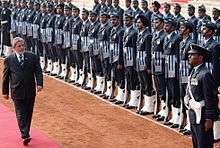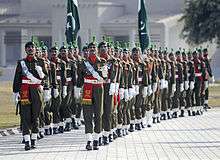Guard of honour
A guard of honour is a ceremonial event practiced in the military and sports throughout the Commonwealth of Nations as a mark of respect.
Military
In the military in countries of the Commonwealth of Nations, a guard of honour is a ceremonial practice to honour domestic or foreign dignitaries, the fallen in war, or a ceremony for public figures who have died. In military weddings, especially those of commissioned officers, a guard, comprising usually of service members of the same branch, form the Saber arch.
For dignitaries
A guard of honour is formed to present formal ceremonial compliments to royal or presidential dignitaries by a guard not exceeding 100 personnel (including three officers, one with a colour) with other particular distinguished individuals saluted by a guard not exceeding 50 personnel. A half guard is a colloquial term describing a guard of honour of not more than 50 personnel (including two officers, one with a colour).[1] A guard of honour could have a single service contingent (e.g. army) or it could be a tri service (inter-service) affair. The guard commander, after saluting the dignitary (usually head of state), marches up to him or her and escorts him or her to inspect the guard (soldiers in formation). During the salute, the national anthems of both the dignitary's country and the host country are usually played by a ceremonial band.
Only a standard, guidon, Queen's Colour, or a banner presented by either a member of the Royal Family or the governor-general may be carried by a royal guard of honour. Only a regimental colour or a banner presented by a personage other than a member of the Royal Family may be carried on a half guard of honour. A smaller unit honouring distinguished visitors at a military installation is known as a quarter guard. The commander is three paces in front of the second file from the right and accompanies the personage for whom the guard is mounted. An officer carrying the Colour stands three paces in front of the centre; if there is a third officer he will be three paces in front of the second file from the other flank.[2]
Australia
The tri-service Federation Guard, consisting of members of the Australian Army, the Royal Australian Air Force and the Royal Australian Navy provides guards of honour for various ceremonies. All members of the guard are enlisted in their respective areas before volunteering for service in the guard. The rifle of choice is the L1A1 SLR.
Canada

The Canadian guard of honour is formed from members of the Ceremonial Guard, which comprises persons drawn for a limited time from all branches of the Canadian Forces (CF). The guard of honour is mounted on dates such as Canada Day and Remembrance Day and will be inspected by the most senior dignitary in attendance. It can also be formed for repatriation ceremonies for fallen soldiers reurning from combat areas abroad.
India

In India, the guard of honour is provided by men or women drawn from three services of the Indian military: the Indian Army, Indian Air Force, and Indian Navy.
Malaysia
The guard of honour in Malaysia usually consists of the 1st Battalion, Royal Malay Regiment, which performs most ceremonial duties in Malaysia, such as Heroes' Day, visitation of diplomats and state leaders, National Day, guard duties at the Royal Palace of Malaysia, and many more, in the national level.
The RMR also mounts the guard during state visits to the Ministry of Defense.
State level guards of honour are mounted by the following units aside from the Royal Malay Regiment, which is also the guard of honor for the states of Kedah, Perak, Selangor and Pahang:
- Royal Ranger Regiment - Perlis
- Royal Armoured Corps - Terengganu
- Royal Johor Military Force - Johor (the only state level defense formation and one of Malaysia's oldest military units)
- Royal Artillery Regiment - Kelantan
- Royal Regiment of Engineers - Perak
- Royal Signals Regiment - Negeri Sembilan
Units of the Royal Malaysia Police in Melaka, Penang, Sabah and Sarawak, as well as the Royal Malay Regiment and the Royal Rangers, mount guards of honor of the governors of these states.
Honour guards units of the Royal Malaysian Navy (RMN Honour Guard Battalion, Lumut) and the Royal Malaysian Air Force (RMAF Honor Guard Battalion or the RMAF College) are mounted in the presence of the Sultan of Selangor and the Sultan of Pahang, respectively, in events where each of the two service branches are involved. Visits to the MoD building by naval and air general and flag officers are also accompanied by the guard of honor units of these services.
Guard of honour units are also found in the Royal Malaysia Police, the Fire and Rescue Department, and the Malaysia Civil Defence Force.
Pakistan

In Pakistan, the guard of honour is provided by men drawn from three services of the Pakistan Armed Forces: The Pakistan Army, Pakistan Air Force, and the Pakistan Navy.
Singapore
The guards of honour of Singapore are handpicked from all three services to be at the forefront of major parades and state events, such as the National Day. They dress in ceremonial attire and will have bayonets attached to their rifles. They will usually be contrasted by one or more contingents of men in regular uniform.
For state visits and ceremonial duties in the Istana, the guard of honour that is mounted is provided by personnel from the Singapore Armed Forces Military Police Command.
Sri Lanka
In Sri Lanka, the guard of honour is provided by men drawn from three services of the Sri Lankan Armed Forces. The Sri Lanka Army, the Sri Lanka Navy, and the Sri Lanka Air Force. During the colonial era, the Lascarins provided the local guards of honour, apart from British Army, British Indian Army, or Ceylon Defence Force personal. Indian Prime Minister Rajiv Gandhi was assaulted by a member of the naval guard of honour in Sri Lanka.
South Africa
The guard of honour unit in South Africa is the State President's Unit (Staatspresidentseenheid) until 1990[3] and today's National Ceremonial Guard.
United Kingdom
Units that traditionally perform ceremonial duties, such as Guard Mounting (changing of the Queen's Guard) or Trooping the Colour, are the five regiments of Foot Guards and the Household Cavalry (Blues and Royals and Life Guards), which form the Household Division. The Royal Air Force's ceremonial unit is the Queen's Colour Squadron. The British Armed Forces do not have dedicated ceremonial units, although some units such as the Scots Guards have a battalion designated to perform public duties. Generally, units from all three services not deployed overseas will rotate and share public duties at various major historic landmarks (e.g. royal palaces and castles) through the country.
The Queen's Guard is primarily made up of units from the Household Division for royal palaces and public monuments—namely Buckingham Palace, St James's Palace, Windsor Castle, and the Tower of London—and other units from all three services of the British Armed Forces filling in when not deployed; in Scotland, Holyrood Palace and Edinburgh Castle are usually the responsibility of Scottish regiments or units based in Edinburgh.[4] Occasionally units from Commonwealth militaries are given the honour.[5]
Sports
Cricket
In cricket, the guard of honour is used to celebrate the achievement of a player (usually as a batsman), normally used during a player's final game. The players' team mates or opposition form a cordon, with their bats at the second count of the draw saber forming an arch, and the successful player walks through. It may also be performed to mark a milestone, such as when a player breaks a world record. A player can receive guard of honour multiple times as they retire from different forms of the game separately. When a bowler retires, it would generally be when they leave the field for the final time, or when they play their final match in a certain venue of importance (away match, home ground, retiring on the same day a ground is due to be demolished).
Association football

In recent years, association football teams have shown their appreciation to the champions of their own division by the players of one team applauding the league winners (the other team) as they appear onto the pitch. The applauding team forms two lines to make a corridor and the league winners run through the corridor, single file. The same has been done for an individual player—such as when Scottish Premier league team Rangers squad did so for departing tallisman Dado Prso—or when a team reaches a milestone—a guard of honour was held on 28 April 2013 by the Arsenal players after Manchester United won the league title for 20th time.
Australian rules football
In Australian rules football, players will often form a guard of honour for those who are leaving the field after a landmark game or on their retirement game. For example, Fremantle formed a guard of honour for Fitzroy's last match in 1996. Melbourne and Essendon formed a guard in 2005 to honour Indian Ocean tsunami victim Troy Broadbridge. Collingwood and North Melbourne formed a guard of honour in 2006 for retiring player Saverio Rocca, who forged a successful goalkicking career at both clubs. After playing in the little league at half time of senior matches, the junior players line up to form a guard of honour for when the players return to the field.[6]
See also
References
- ↑ RAF Drill and Ceremonial AP 818 7th Edition
- ↑ p.128 Guards of honour from Ceremonial 1912
- ↑ "State President's Unit". South African National Defence Force.
- ↑ The Queen's Guard – British Army website
- ↑ "Navy News – On guard". Department of Defence. 7 August 2000.
- ↑ Pedler, Emma (30 July 2013). "Port Power missed our guard of honour".